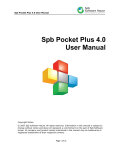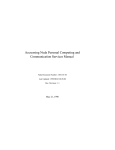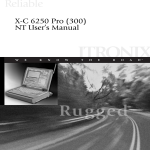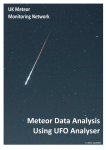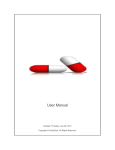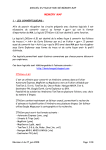Download Mio A701 System information
Transcript
E-TEN G500 vs. Mitac Mio A701 This test was sponsored by the shop PDA plaza, located in Budapest, Hungary. They lent me two GPS-PDA-phone devices to test for a week. They were the Mio A701 and the E-TEN G500, both brand new on the world market. The two devices are common in many aspects: on contrary to their compact design, both are equipped with a built-in Sirf III GPS receiver, they run Windows Mobile 2005, they both have a built-in camera etc. Through the test, I will compare them in several aspects one-by-one, and will mention the winner of each specific category. I will try to be as objective as possible. 1. What’s in the box? Mio: according to the box it contains the device itself, an extra stylus, a leather carrying case, a USB cable for synchronization that can also charge the device, an AC adapter with two plugs (British and Central-European), a windshield holder for vehicles, a 12V car charger and a screen protective film. Even though it’s said, the leather case and the screen protector were missing from the box, but this is supposedly only because this was a testing example. There is however also a stereo headset, an installation CD and a short manual in the box. E-TEN: the box says it contains the following: G500 device, car charger, windshield holder, USB cable for synchronization and charging, AC adapter (it’s an American standard charger with two European plugs, however, only the British was present. Hopefully the reason again was that this is only a test device. I had luck that I own an American-European converter plug), stereo headset, leather carrying case, manual and installation CD. The content of this box was correct; all the items were present. It’s a pity though that you don’t get an extra stylus. But you do get a screen protector and a practical, alcoholic cleaning tissue to get rid of the dirt from your car’s windshield before mounting the holder. The Mio’s box is not a practical design. While the G500 and all its accessories are put in a cardboard, well-shaped holder, in the Mio’s box only the device itself is protected, the rest is just “thrown” in the box. Of course if well-packed, nothing can be damaged there either. The two boxes have ca. the same volume, only their shapes are different. In the “provided accessories” competition the Mio wins. (Many more pictures can be found here: http://digitus.itk.ppke.hu/~tomiki/drupal/teszt/pics) Before using them for the first time, they both requested a full charging. They disliked the use right after getting out from their boxes. After the long, 6-8 hours charge, they operated happily. Sizes: The Mio’s GPS receiver has a well designed antenna end, which makes the device as long as the E-TEN. In width and thickness, as well as in weight, the Mio is the smaller, therefore the winner. Sizes, weight with factory battery: Mio: 107 x 57 x 18,8 mm, 148 g E-TEN: 119 x 62 x 23mm, 190 g 2. Design, shape and buttons To decide, which of the two is more beautiful, I think, is a woman’s job. Men cannot make such decisions when buying a technological device :) The colors and metal insets make the Mio very elegant and professional looking. Its size is also rather like a mobile phone (it’s only somewhat bigger than a Nokia 3310) and the touch of the housing is also very gentle and pleasing. The E-TEN makes rather a PDA impression, with its symmetric design and smooth surface. The blue-colored, illuminating thin line running around the buttons and the screen looks very cool. Also, the big GPS sign on the top shows that we’re not dealing with some cheap crap here. When using them as a phone, both are very handy. Those who prefer lighter devices might notice that the E-TEN is heavier. For me, using an HTC Blue Angel, both of them seemed very lightweight, but I must admit that also I noticed the considerably less weight of the Mio. Regarding the hardware buttons and their amount, the G500 wins. On the Mio’s left side, there’s only the two volume buttons, which are definitely not easy to press. The right side owns the photo-button, activating the camera, and the SD card slot. The front panel consists of the screen, the five-directional navigation button and four other buttons: two (red and green) for the phone, one for Windows Media Player and one for the navigation system that we can install on the device. The five-directional joystick reminds me of that of the HTC Himalaya (XDA/MDA II) that was basically useless. Luckily the designers of Mio separated the middle action button from the four directional pad (unlike at the Himalaya, which made it useless). While using it, it’s not always sure though, which direction we have activated when pressing the circular dial. This might be difficult for those with bigger fingers, but even for those with normal size fingers it needs to get used to. Turning the Mio on/off is done by pressing the red phone button. This is solved in a very stupid way, as for turning the device off, one needs to push the red button for 3 seconds and then touch the screen on the word “Sleep.” Turning on is done by pressing the red button shortly. This, however has a bad side effect: the last activated program gets minimized, as the red button’s secondary operation (primary is hanging up the phone) is the substitution of pressing the on-screen X in the upper-right corner, thus minimization. The five-directional navigation button of the E-TEN is also strange after using the Blue Angel. One can be sure of which direction is pressed on the rectangular dial, but the action button in the middle is too short and is too deeply submerged in the housing, making it difficult to push. But once it’s pushed, a nice click can be felt, thus we are aware that our command was given. Using this dial, the action button definitely needs to get used to. The other hardware buttons are also submerged in the housing, but they can be found easily, even without looking, thanks to the small patterns on them. This is on contrary to the Mio, where none of the buttons on the front panel can be “touched out” blindly. The G500’s front panel provides the red/green phone buttons, two soft-keys above them that always do what is written above them (this is a WM5 feature, similar to that of the Nokia cell phones). Above the screen there are two other buttons. The default settings are: one for E-TEN’s own software, M-Home or M-Desk, whereas the other is meant to launch the navigation system we install. The left side provides a slide button for volume, the camera activating photo-button and another button without any default function. The slide button for the volume is much easier to use than the Mio’s volume buttons. The right side owns the on/off button (submerged in the housing so that it cannot be pushed when having the machine in our pocket). This is a great advantage to the Mio: one can turn on/off the G500 as other PDA’s: short push for on/off, long push for backlight on/off. All hardware buttons on both devices (except the phone buttons and the navigation keys) can be programmed for any function or installed software, which is a Windows feature. The reset buttons are on the sides, right side on the Mio and left side on the E-TEN. To compare the five directional navigation pads, I think that the Mio’s one is a tiny little bit better. The key lock is much simpler and user-friendlier for the E-TEN: when the device is turned off, it reacts to nothing, except the on/off button. The Mio however by default reacts to all the buttons and also to a touch on the screen, so it’s better to use the built-in lock feature. Once this is on, turning the Mio on consists of pushing the red button, then touching the screen where it says “Unlock” then the Unlock word moves away on the screen to another location where it has to be touched again. I find this “too sure” and therefore too complicated. The plug of the A701 is a standard mini USB, which gives several advantages: if we don’t have its own synchronizing cable on hand, we can use any other mini USB cable to connect our Mio to a PC and synchronize and/or charge it. Another advantage is that both the AC adapter and the car charger provided along with the Mio terminate in a mini USB plug allowing us to use them to charge other devices, such as digital cameras, mp3 players etc. Or, when traveling, it’s enough to carry the charging and synchronizing set of the Mio and use them for our other machines. The G500 has its own standard, “PDA-type” plug, with many connecting pins. Its AC adaptor, however, doesn’t terminate in a “PDA-standard,” yellow-colored plug where one can simply attach his own PDA’s specific “charging head,” but it ends in a ca. Nokia-sized plug. You also don’t get a “charging head” to it, but have to connect the USB cable’s head to the AC charger, and plug that in the device! Horrible solution from E-TEN, used also by the M500 and M600. The USB cable is then just loose and bothers while charging via the AC adaptor. All this mess makes us decide rather not to use the AC charger, but the USB cable (to charge from the computer) and the car charger. However, the manual recommends to charge the G500 every once in a while with the stronger AC adaptor. It also recommends charging via the USB cable parallel with the AC adaptor. No comment about all these crazy ideas…Anyways, we can charge the device in several ways. The USB synchronizing cable from Mio is thicker than the other, giving a massive and strong impression. The E-TEN is thin, therefore it needs less room to store in our bag or pocket, but one might think that it could break easier. However, E-TEN has supplied this type of thin cables to its previous devices as well, and until now, nobody has complained about cable-breakage. Both devices own a telescopic stylus and they are located at the bottom of the housing on the right side because of the GPS antenna on the top. I like the one of E-TEN better because it’s easier to get out from its holding hole, but it’s still stable inside, and doesn’t fall out by accident. It needs a little more force to lengthen it, but its length is more than enough to work with even in the shorter version. Once it’s lengthened, it’s longer than a “standard” stylus, and becomes very handy to use. This is also thanks to its thickness. It’s a little impractical that the stylus is held also by the back cover, so once the battery is taken out (e.g. for a SIM card change), the stylus also falls out. To get out the Mio’s stylus is very difficult, but lengthening it is easier. This results in that while the E-TEN stylus comes out collapsed, the Mio arrives in the open status. It happened that the Mio’s stylus broke (!) or the two parts fell apart. Somebody also struggled with having the bottom part stuck in the housing, causing big trouble getting it out. This cannot happen with the E-TEN’s stylus, as it is built very massively, and is very stable. The Mio stylus, when collapsed, is very short, so you need to lengthen it first before each use. This is not a big deal, as when you take it out from the device, it’s already open. As a summery I’d say that the E-TEN stylus needs to be opened only if we want to use it for a longer period, but for just a couple notes, it’s long enough when it’s not pulled apart, and this is an advantage. In the stylus competition, my winner is definitely the E-TEN. 3. Screen The precise, visible sizes: Mio: 54.5 x 40.5 mm (diameter: 68.5 mm) E-TEN: 57 x 43 mm (diameter: 71 mm) So the G500’s screen is a tiny bit bigger than the one of the Mio. Their resolutions, of course, are the same: QVGA, (240x320), 16 bit (65536) color depth. In order to have a fair competition, I compared the screens with maximum backlight. Their sharpness is practically the same; however the Mio, probably because of its smaller pixels, felt a little better. If we look at the screens from angles and not directly (90 degrees) from the top, first the G500 becomes more difficult to read even though its letters are bigger. Looking on the screens from the devices’ tops, the Mio’s screen starts to change colors: greenish, redish colors appear on the texts, which are really bothering even though they don’t influence the reading abilities. The G500 remains clear even from the angles; however at 90 degrees the E-TEN has more light, looking from the sides it becomes darker than the Mio. Using the E-TEN when we enable the screen’s backlight to turn off, it doesn’t mean that after the set time interval passing the screen becomes completely dark, but the device goes to power save mode and sets the backlight to minimum. In power save mode the blue line running around the screen remains lit and the screen is also visible and readable. I find this practical as this way one can easily find the G500 in darkness and can also have a look at it, whether it needs attention. If the automatic off is also enabled, having its time passed also, the device turns off completely (i.e. goes to sleep mode, but, of course, remains in the GSM network). To make this clear, let’s have an example: I use my PDA in the following way. Running on battery, it turns off the screen backlight after 30 seconds. After another 30 seconds (all together one minute) it turns itself off completely (Sleep mode). At the tested device this happens in the following way: E-TEN: 30 seconds pass, the screen light becomes minimal (blue line on, screen dimming). Another 30 seconds pass: the device turns itself off. The G500 has also another feature: running on battery, the machine can adjust the screen brightness automatically. This means that the setting bar becomes disabled, but it remembers our last brightness setting and uses that as a maximum. During the first 30 seconds period, the G500 sets the backlight strength automatically: it gets reduced every once in a while, but when we touch the screen, it lights up to the previously set maximum. Mio: 30 seconds pass and the backlight becomes turned off, as well as the screen! The device looks like it’s in Sleep mode (black/blank screen, no light). If we touch the screen or any of the buttons, it wakes up. Having another 30 seconds passed, the Mio turns into Sleep mode (without giving us any sign of this) that can be noticed by no reaction to touches on the screen or the buttons (if key lock is enabled). By pushing the red button, the Mio wakes up (and asks for Unlock is set so). The E-TEN’s screen seems to flicker if the backlight is set to a lower level. It feels like that the video chip would miss a refresh cycle, when the screen is touched. This is of course, not serious at 50-60 refreshes per second, but still, it’s like something is happening or not happening. Using Clear Type both devices act the same: they become fuzzy and unreadable to me, but those who are used to it, will find this feature useful. As a conclusion I say that altogether the screens are the same, the Mio is a little sharper, and brighter, the E-TEN’s is a little bigger. The Mio is very battery friendly, whereas the E-TEN is more user friendly with the thorough backlight settings. 4. Phone The Mio’s GSM module is triband, the E-TEN’s one is quadband. This cannot be tested in Europe as here only the 900/1800 MHz frequencies are used and our cell phones switch between these two without any sign (according to which network is more crowded). The 850 and 1900 MHz frequencies, used in the USA and in Asia are similar to the European ones: they are usually present simultaneously, so the cell phones are able to find either one. Still, one can say that it’s a tiny advantage of the E-TEN that it also works in the 850 MHz range. In voice quality, the Mio seems better than the E-TEN. Calling them, I could hear my friend calling from the Blue Angel a little better when I had the Mio in my hand. My friend heard me as good with the G500 as with the A701, but I heard him not so clearly and good with the E-TEN. Their ringing is not loud enough, both of them are too silent, so one depends more on the vibration when having the PDA in the pocket. I’m not saying that my Blue Angel rings loud enough, but having a well chosen ring tone with high pitches, the BA can yell if it wants too. The G500 and the A701 are more solid in this sense. Both devices have GPRS, but the E-TEN also supports the CSD (modem-type) Internet connections. Because I have to make a decision, here the Mio wins because of the voice quality difference. 5. GPS Both devices have very-very limited (basically no) instructions in their manuals regarding the built-in GPS modules. They both leave the settings to Windows and the user’s navigation software. This is OK, if one has a nice navigation software setting the GPS automatically. Both GPS modules are set by default to COM4. This is funny though because my navigation software (iGO) worked on COM2 on the Mio. iGO can be bought only on its own SD card, so I couldn’t run it on the E-TEN as it’s equipped only via a mini SD slot. In the Mio’s COM port list, COM4 is an “Active Device” and COM2 is the GPS even though in Settings the GPS port is set to 4. My other navigation software, GarminQue + GPSProxy (running on both machines) however used COM4 on both PDA’s. It was pretty difficult to set up GPSProxy on both devices. The E-TEN’s settings are very difficult. We don’t have any information of the GPS module, if no automatic configuring software runs on it (I tried installing Destinator 3.0.75, but neither of the machines accepted the installation for unknown reasons, as the WM5 compatibility settings were made). Finally I installed GPSProxy and Garmin Que on the E-TEN as well and started to figure out the GPS information. I knew that COM4 is the used port (could read it out from Settings), but I knew not the baud rate. Trying 57600, 9600 and everything, finally, after two hours of pain, I set it to 4800 bps and then it finally started to work. Forgetting these pains above (if one buys an E-TEN after reading this test, he’ll know what the settings are because I figured them out) one difference between the GPS modules is their transmission speed: 57600 (Mio) vs. 4800 (E-TEN) bps. By the way this is absolutely no disadvantage to the G500, as according to the GPS standard, a GPS receiver sends one “GPS sentence” every second and a sentence is usually 50-100 characters long. This is 50-100 bytes = 800 bits for every second. This clarifies that the ETEN’s 4800 bps is more than enough for GPS operation. Sensitivity: I called “cold boot” the case when the GPS was turned off for at least 10 hours. The Mio’s receiver found its location after a cold boot in ca. 2-5 minutes, whereas the E-TEN in ca. 4-6 minutes. I called “warm boot” the case when the GPS was turned off for ca. one hour and then turned back on. For “hot start” I meant a short “no signal” period (e.g. in a tunnel). Both GPS’s found their locations with the same speed: 20-60 seconds for warm boot and 5-10 seconds for hot start. Once they found their position, they didn’t let it go easily. Even in a vehicle having them on the seat they navigated precisely. Conclusion: the G500’s receiver cold boots on an average one minute longer than the A701. Other than this, their accuracy and warm/hot start times are absolutely the same. The E-TEN also has a built-in TMC chip supporting TMC (Traffic Message Channel). The TMC uses an FM radio’s RDS signals and if a radio station broadcasts TMC signals about traffic jams and constructions etc., the E-TEN, having a TMC supporting navigation software running, is able to reroute our track according to the jams. This TMC support means that the E-TEN owns a built-in FM radio (!). The only lack is that this is not yet supported by the operating system. E-TEN promises the upgrade to come out in May-June. The Mio is also prepared to TMC support, but its TMC chip is built in the separately available, active car-holder. 6. Default software through the eyes of a beginner In this category the E-TEN wins a lot above the Mio. It has its own made software to almost all resources one would use. These usually operate Windows functions, but in a more user-friendly way and there are also some additional functions as well. For example there’s a built-in Bluetooth Manager that not only enables simple BT connections, but also functions e.g. as an FTP client. This way we can connect our G500 to another PDA or a PC and transfer files in a File Manager type window. Due to the Bluetooth driver’s lack, it can only transfer files (no folders) and them also just one-by-one, but still, this is a really convenient way to connect to another device. We can also browse the other device’s memory, storage! The E-TEN also has a cool Wireless Manager app that enables the turning on/off of the GSM and Bluetooth modules either one-by-one or both at the same time. There’s also an SPB PocketPlus-type Today plug-in showing eight icons at one time, but with large arrows, the icons can be shifted, and so, if one wishes so, all programs and functions of the PDA can be accessed simply from this plug-in. What I found very useful was the size of these icons: they all are huge, allowing the dismissal of the stylus; we can simply use our fingers to launch the programs via these icons. When we push the M-Home/M-Desk hardware button, we arrive at the special E-TEN menu with its own design (all the functions listed in here are also accessible from Start/Programs). Here we can run all E-TEN programs (listed below), whereas some more useful functions also have their icons on the Today screen’s bottom right corner. The E-TEN, besides the above written ones, has the following built-in functions and software: speed dial, call filter, MMS sender, sound profiles (such as in a Nokia or Siemens cell phone), a very thorough camera app with many settings options, a PaintBrush-type image maker, Multimedia file utility, imaging tool, voice commander and a backup utility. Here I shall note that the E-TEN has an outstanding extra: when the phone’s red button is kept pushed, it turns on/off the Flight mode (the GSM module)! This spares us using the stylus to touch the antenna icon and then in the bubble the “Turn on/off flight mode.” I found this very useful. This, of course, doesn’t turn the PDA functions off and no Sleep/Power off menu comes forward as when using the Mio. I like the E-TEN because it’s user-friendly, allowing in general the usage of our fingers, no need for the stylus all the time. The E-TEN’s system information is shown in a File Explorer-type, folder-tree structure. Below are some snapshots from the E-TEN’s operating system. Device information Backlight settings Backup utility Bluetooth manager Call filter GPRS connection manager Error reporting Imaging tool PaintBrush E-TEN M-Desk Profiles Today, today plug-in Dialing pad Speed dial Memory information System information The Mio’s default software is much simpler and lesser. It also has a Today plug-in, that can only show five icons. The camera app, similarly to the G500, has several options, but these are a little more difficult to access, and the stylus is needed for them (on contrary to the E-TEN’s on screen camera menu with again large icons). The Mio has a GPRS connection manager with some of the Western-European phone providers’ GPRS settings pre-set (the E-TEN also has an empty one). The Mio also has an app called Location Call that allows us to send (automatically) emergency SMS messages to predefined numbers including our GPS location in them. It also has a program called Quick Position that can download via GPRS the locations of the GPS satellites in the near future making the cold boot considerably faster (I didn’t use this feature during the test). There’s also a so called Mio menu, which has only one function: those programs have a big icon in it that are considered important. It’s basically a clone of parts of Start/Programs. These are, however, only basic Windows apps, not as by the E-TEN MHome. The Office tools (Word, Excel, PowerPoint) are put in a directory under Start/Programs, making the menu a little smaller and so better utilizable. The Mio’s speed dial, an app called edialer is a very useful and handy tool. Turning on the phone dial pad (by pressing the green button), one only needs to start typing in t9-style the name of the person who should be called, and edialer finds all the people in the contact list, whose names contain the yet typed-in string. This speeds up finding contacts a lot! The Mio allows more thorough settings operation-wise. One can set the processor speed (to save battery), we can set if the devices should turn off the SD slot in some cases, and another great option: the memory card in the device’s SD slot can be used as a regular flash/pen drive when the „Card reader mode” is enabled at the USB settings. In this case when the Mio is plugged in a computer, it doesn’t start to synchronize via ActiveSync, but the SD memory card becomes a drive in the PC! A very practical option, even though Total Commander users had this possibility for a long time using Ghisler’s (author of TC) WinCE plug-in. This plug-in allows accessing the whole memory of a PDA (not only the SD card, but also the folders, such as Windows, My Documents and Storage etc. as well) as a Network Drive. Below are some Mio snapshots. Device information Bluetooth „manager” Preinstalled GPRS settings Quick Position for the GPS System information Memory information Camera settings Location Call Mio menu Performance settings TMC support Phone panel and edialer Today, today plug-in Power settings USB mode settings In the pictures above, one might notice the little color change in the Mio’s letters: this is what I meant in the Screen chapter. In the preinstalled, default software competition, the E-TEN wins miles ahead of the Mio, even though the Mio has edialer. Soft resets needed to be done as frequently for both devices. 7. Bluetooth Both machines have a good and strong Bluetooth interface. They connect, pair and communicate nicely with other devices. The G500 has a little disadvantage: its blue LED blinking when BT is on is so strong, that in darkness or dimming light it’s even bothering (I had to cover it with my fingers). However, this makes BT operation visible by daylight too, which is, on the other hand, an advantage. The Mio’s Bluetooth manager is very poor, but when the machine senses some other BT device around it, connection is started promptly and accurately. I don’t own a BT headset, so I couldn’t test this feature of them. According to fellow forum contributors, they both handle BT headsets nicely. In Bluetooth the two of them are of the exactly same quality. 8. Camera Both cameras are 1.3 mega pixels. The E-TEN’s highest resolution is 1280*960, whereas the Mio’s is 1208*1024, so a little bigger. Their camera tools have many setting options. The E-TEN can store the images in both JPEG and BPM format and it also has more pre-settings for surroundings, such as daylight, lamp, dusk etc. The Mio doesn’t have this kind of features. They both can ZOOM, which of course only means enlarging some parts of the image. The E-TEN allows setting of the white-balance also. The following are the features both devices have: self-timer, series, refresh frequency (50 or 60 Hz). Their video modus is also similar, highest resolutions are 320 x 240 and they both can record voice as well. So the only differences here are the E-TEN’s little more thorough settings, but the photo and video qualities are the same. (I find it enough just for playing, as with all CMOS cameras in phones.) Pictures, videos taken via their cameras can be found here along with all of the images of the devices: http://digitus.itk.ppke.hu/~tomiki/drupal/teszt/pics 9. Headset The given headsets’ design and quality are the same. You shouldn’t listen to concerts or Mozart on them, but they both have good phone voice quality, and even mp3 files sound good and they are also loud enough. I didn’t notice any difference between them and my Blue Angel’s headset. 10. Performance The machines boot with the same speed, the Mio is about 3-4 seconds faster. Both devices had the factory pre-installed software, GPSProxy, GarminQue, MagicSS snapshot tool, TCPMP media player (used to be Betaplayer: a very handy tool to play back divx movies) and the Mio also had iGO installed (ca. 2 MB). When they booted, none of these programs were launched, except for the factory plug-ins, the others only used up some space in the memory for their files. For performance tests I ran SPB Banchmark (35 minutes) and TCPMP’s Benchmark test with a five MB mp3 file. The results are as follows (the bigger number is always the better except for TCPMP’s “Running time”): Test Writing big files Reading big files Copying big files Writing many files Reading many files Copying many files Listing directories Pocket Word Pocket IE – HTML Pocket IE – JPEG File Explorer ZIP JPEG Arkaball Memory operations Memory operations TCPMP Average speed Running time Sample rate Data rate Mio A701 E-TEN G500 HTC Blue Angel 1344.900000 60.000000 1639.200000 5236.000000 303.900000 4608.600000 1974.500000 39247.200000 3757.400000 1728.400000 5950.900000 4691.400000 385.700000 4.990000 3747.300000 7820.200000 1231.400000 310.600000 1244.900000 3696.000000 424.600000 3796.200000 1255.800000 27419.700000 2933.400000 1747.100000 3491.000000 3729.500000 656.400000 5.955000 4561.000000 9632.800000 2376.800000 844.800000 1565.900000 4427.400000 1058.500000 4179.300000 164.900000 7260.100000 3569.900000 1175.100000 9188.100000 7251.600000 514.600000 8.705000 4967.000000 10178.800000 1106.83% 0:28.769 488172 2.1 Mbit/s 823.61% 0:38.613 363239 1.6 Mbit/s 1020.56% 0:31.162 450108 1.9 Mbit/s The SPB is not a perfect test, as it benchmarks more likely the memory operations and not the processor performance. Reading/writing files, directories etc. need fast memory access, and not fast CPU calculations: However, for business people it’s very important that their PDA can handle many and big files, so that reading e.g. a long Word document doesn’t freeze the operating system. Still, this didn’t allow us the wanted Samsung vs. Intel CPU test, but we can still accept the results, as the overall performance shows something about the CPU’s power as well. The Benchmark tests are won by Mio, with big advantage. However, it’s very important to note that even though the E-TEN was the poorest in Benchmark tests, in every day usage it’s not slow at all, in fact, accessing of Start/Programs and browsing there (causing often problems for the Blue Angel) was even faster than in the Mio! Using the navigation software, the G500 was again faster; it also needed less time to launch GPSProxy. So in every day usage neither of the machines is slower. The batteries performed the same, but with constant navigation the Mio seemed to consume more energy. I wasn’t able to test the machines how long they last with one charge, but the Mio ran out of power twice during the test period (one week). I think though that this was due to the more playing around with it and less charging. 11. ROM support There’s no ROM upgrade yet for either device, but I assume that E-TEN will be better, as it’s famous of fast upgrade support, almost as fast as HTC. It already promised the new release supporting the built-in FM radio. Mio, however, has never ever released any ROM upgrade to its machines, so we can only hope that they will change their minds and stop this secret life of updates or no updates. However, since there are no upgrades out yet to any of the two, I don’t call for a winner in this category. 12. Personal experiences, human opinions According to the above written, the Mio wins in six categories, the E-TEN wins in six categories, and they are the same in the remaining seven categories. So in general there’s no difference between the devices, so if decision has to be made, it has to become personal. My personal opinions are as follows. Mio Pro size design faster GPS (experienced GPS manufacturer) a little better screen (depends on Today scheme) better phone quality good quality leather case Contra worse performance than expected very-very few hardware buttons fragile, thin stylus (might break when pulled out halfway) complicated “on/off” and key lock poor preinstalled software E-TEN Pro bigger screen many hardware buttons excellent preinstalled software good stylus cool GSM handling cool backlight settings Contra bigger size and weight slower GPS cold boot (even though it’s made by RoyalTek) strange (worse?) phone quality poor leather case stupid AC charging solution As a personal conclusion I must say that for me the E-TEN G500 won 55 to 45. However, I still won’t buy any of them to exchange my Blue Angel. I would do that only if I were forced to do it. But then I would by the G500. For those, however, who would like to make a decision, this test my help giving an overview of both machines. I hope that I could be generic and objective and that this test helps you folks to decide, which one you’ll buy.














